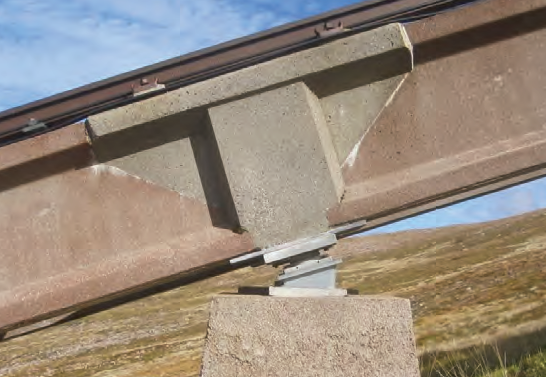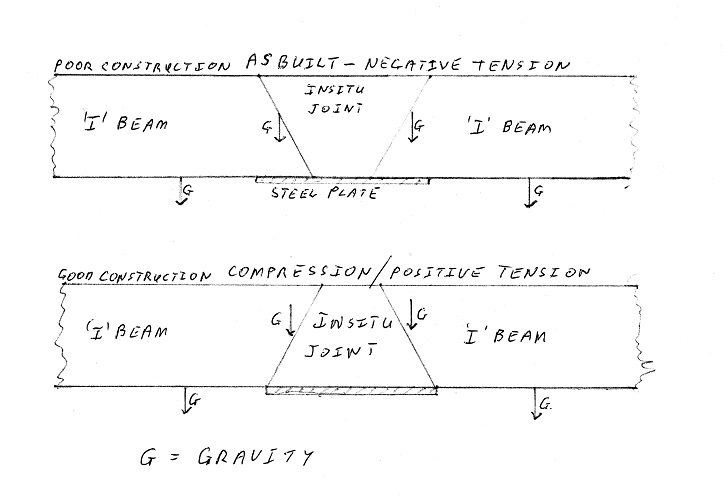While researching why the funicular was beams were built out of concrete rather than steel (see here), apart from being told that the beams should have been deeper, “tensioning” was mentioned. I didn’t appreciate the importance of what was being talked about at the time but then, after my last post (see here), this comment appeared:-
It suddenly dawned on me. Look at the next picture. The slope on the ends of the “I” beam appear the wrong way round.

The only part of the structure being well supported is the wedge shaped insitu joint. The last few inches of the “I” beams have a steel plate underneath which, as I explained (see here), was too small to prevent the end of the beam cracking up but the joint also does nothing to prevent the beams pulling away from the piers. The whole structure is “in tension”, not compression, due to the force of gravity.
If the end of the “I” beams had been manufactured the other way up, i.e. the top edge longer than the bottom, so that they sat on the piers rather than being suspended between them, then the more the weight put on the beam the more the compression/ strength would have increased.

This appears to be either a design fault by Crudens or a mistake on the part of manufacturer: since the “I” beams would have been moulds upside down (see here) it would be easy enough to get the shuttering for the ends the wrong way round. However, if the manufacturer got something wrong, Morrison Construction should have noticed the mistake and HIE could have sued them!
It appears more likely therefore that the problems with the joints are due to a fundamental design fault. That may partially help explain the £11m out of court settlement HIE reached with the successor companies to Crudens and Morrisons (and Natural Retreats) this summer (see here). If so it begs the question, did HIE recover enough given the £25m repair bill?
The implications of the funicular structure being “in tension” for the future
HIE’s announcement on 13th October (see here) that the re-opening date for the funicular was being delayed yet again because “the tension of the ‘scarf joint assemblies’ …………………….fell below the designated level” indicates the seriousness of the problem.
If the joints were under the correct tension when the funicular re-opened in January (Information Requests have been submitted to establish whether this was properly checked and the funicular was safe to use) that would suggest the impact of just six months use of the funicular was sufficient to make the whole structure unsafe. If so, there are serious questions to be asked about how long the current adjustments to the tension of the insitu joints/scarf joint assemblies will work.
There appear two possible engineering solutions:
(1) An extra pier with all its accessories is added under each “I” beam to spread the load. This would require a new planning application, add yet more concrete to the mountain and is not 100% guaranteed to work, or (the better option);
(2) Replacing all the “I” beams and insitu joints. In this case the only sensible option is to replace the concrete beams with the cheaper and lighter alternative, STEEL. (see here)
The cost of either is likely to considerable unless HIE can recover that through a further court case against COWI, the designers of the repairs, and the consultants who double checked the repair design. The Scottish Government is unlikely to be pleased to find out that they have wasted circa £25m on repairs/ strengthening that have not worked as expected and politically it would be very difficult for them to fork out yet more public money on a new “solution” for the funicular!
If the Scottish Government refuse further funding, HIE could be forced to permanently close the funicular, at which point a decision will have to be made over the future of the whole resort. None of this disaster would have happened if HIE had not been obsessed with the funicular and had been prepared to consider a modern and much cheaper lift system capable of carrying mountain bikers to mid-station as well as skiers.
What needs to happen for the winter
If HIE fails to re-open the funicular in the next few weeks that should not stop Cairngorm Mountain (CMSL) from providing for snowsports at Cairn Gorm (in the last couple of days there has been snow down to the car park).
HIE has provided CMSL with c£1m of snow making equipment, a snow factory and 13 snow cannon. There should be enough capacity in that equipment to provide snow cover from the bottom of the Cas tow to the Day Lodge, IF IT IS USED TO MAXIMUM EFFECT WHEN CONDITIONS ALLOW! That is now down to staff at the ski centre who CMSL claimed to the Cairngorms National Park Authority “are best placed and have the knowledge of what is required to make the ski area better”:

Your observation is correct but the “compression” joint is far harder to construct: you would need to have the “crosshead” on the pier constructed first, then land the beams onto it. Stitching the beams to the crosshead would then be very difficult, and the crosshead itself would be unstable during construction so would need difficult/expensive/hazardous temporary works.
There are many flaws with the original design – some, I understand, so basic that they are beyond belief but the joint in tension because of orientation is not one of them.
Civil engineering here joint looks fine. I assume it’s pin jointed and not continuous
Jim.
Can you explain “pin jointed” please? In most of the beams there are 3 T32 rebar in the top web which are connected using couplers through the insitu join. There are 3 T40 rebars in the lower web. As far as is known the outer 2 T40’s were cut short. The middle T40 is turned up 90 deg and believed to be welded to the bearing plate as this held the beams in place while the insitu was poured. There appears to be no certainty about the construction of each insitu. The COWI report of 2018 is very helpful although it would appear that they had to make some assumptions as technical drawings are missing and the H & S file is incomplete.
Just get rid of all the ski infrastructure: it’s an eyesore, environmentally degrading and doesn’t make that much money from skiing now global warming gives us more rain than snow in the winter.
What rubbish skiing enablesillions of people toenjoy the mountain environment. Admittedly Austria is the best and people friendly
An answer to your comment in such a small space would not give it the attention it deserves, so, if you watch this space I will reply in a PW post in the near future.
Quite right
Yes, let’s just stay home and eat porridge made with water and look out the window. In fact let’s get rid of windows, environmentally they allow far too much heat to escape….. Twaddle.
Nice one
Do your homework ski resorts will bring in income through tourism plus all the workers will have families to feed.If it weren’t for ski resorts aviemore would be a waste of time so all you people who left negative comments away bike your heads
Bit late now but the plate at the bottom should have been longer, extend the plate at the bottom,,,this is where all the steel reinforcement is at the bottom of the beam.All the pressure from the beam is transferred to the plate ,,,,extend the plate if the beam is failing . The wedge of concrete above is doing nothing except protecting the steel from the corroding and mabey keeping the beam in line.
Ok in despite of the comments about design the clients management team that confirmed the consultants and contractors for the project should have had a third party Engineer either in house and or a Health and Safety advisor and Commissioning engineer that the draft design were acceptable to the client .
I lay the blame with either the Design &Build Contractor Morrison Construction and their design team and / or the HIE and the responsible funders Scottish Government .
Scottish Government have a substantial engineering and consultancy basis to regulate Bridges , roads , tunnels , etc etc that must be responsible in the end for approving taxpayers money for a not fit for purpose public transport service and delays to Highland resort commercial and employment .
Typical of CAL Mac ferries and Kingston Bridge etc SNP typical incompetence on everything .
I rest my case
Da
David, the SNP were not in power when the funicular was completed in 2001, Labour was and had been since 1997. While Fergus Ewing strongly supported the funicular the issue in my view is less about any one political party than how the state operates. Nick
Nice article, highlighting concerns about its impact on the environment and the future of the resort. It raises important questions about sustainable development and the balance between economic interests and environmental conservation in tourism.